Nikon 14-24mm f2.8 G Test Series
Nikon 14-24mm f2.8 G v Canon 16-35mm f2.8 L II v Contax Vario Sonnar 17-35mm f2.8
> Please see here for the full range of 1DS III and 5D tests of the Nikon 14-24mm G
Continuing our series of Canon 1Ds Mark III tests of the Nikon 14-24mm f2.8 G, we move up to 17mm where the stiffest competition is offered by the Contax N Vario Sonnar 17-35mm f2.8, adapted by Conurus for full autofocus and auto-aperture operation in the EF mount, and Canon's latest Mark II 16-35mm L f2.8. Both copies are believed to be optimal. Andrew Gough, of Planetwide, scrutinised six copies of the L before purchasing this best-of-breed sample. Similarly, the Zeiss N was chosen from a batch of five for his personal use. The Nikon is the same sample used in the other tests, adapted for use on the 1Ds III by our own adaptor.
Resolution & Drawing Style: Zone A (centre frame) at 17mm f2.8
 |
 |
 |
| Canon 16-35mm L II: Zone A at 17mm/f2.8 |
Contax 17-35mm: Zone A at 17mm/f2.8 |
Nikon 14-24mm: Zone A at 17mm/f2.8 |
Resolution & Drawing Style: Zone B (mid frame) at 17mm f2.8
 |
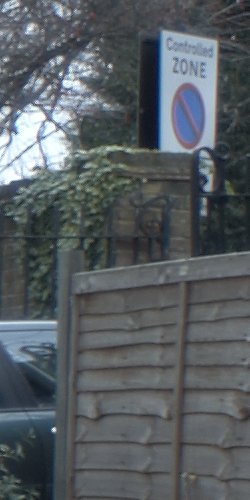 |
 |
| Canon 16-35mm L II: Zone B at 17mm/f2.8 |
Contax 17-35mm: Zone B at 17mm/f2.8 |
Nikon 14-24mm: Zone B at 17mm/f2.8 |
Resolution & Drawing Style: Zone C (corner) at 17mm f2.8
 |
 |
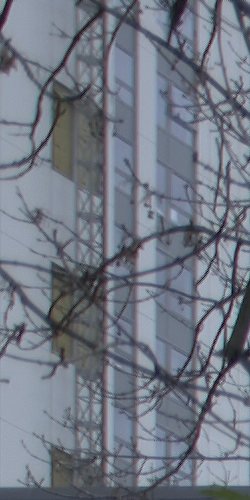 |
| Canon 16-35mm L II: Zone C at 17mm/f2.8 |
Contax 17-35mm: Zone C at 17mm/f2.8 |
Nikon 14-24mm: Zone C at 17mm/f2.8 |
There's some movement in the branches in Zone C which is messing up the parity of our results somewhat, but the Nikon nonetheless shows a clean pair of heels to the other candidates in every way: at 17mm, the 14-24G's distortion is minimal and, despite the Canon's impressive performance, the Nikon outresolves it across the frame.
In this company the Contax shows its age here, with old-school spherical aberration dominating at f2.8 – yet if you peer through the murk, vignetting and all, you'll notice that – in Zone C – fine details are better resolved than in the Canon capture, and almost as well as the Nikon's – boding well for stopped down performance. The 'Zone B Dip' we explored in earlier tests initially seemed to be less pronounced, though a relative performance gap is still present in comparison with the excellent L II and Nikon zooms.
When focusing these lenses, the usual trial-and-error method was used: (guess + capture + big screen preview; repeat until correct), but we were also interested in assessing the utility of LiveView as a focusing aid for these ultrawides. At 10x magnification, it was possible to see the focal plane creep into the distance quite accurately with the Nikon 14-24mm: it's ultra-high resolution and sharply etched microcontrast works perfectly in tandem with LiveView at f2.8. The Canon L, too, offers good 'focus-ability' when you concentrate on the center of the frame. However, the Contax proved considerably more troublesome: the low contrast rendition, Zone B oddity, and some wobbly field curvature, makes it tough to pin down where the focal plane lies, and considerably more trial and error was needed in its case.
Resolution & Drawing Style: Zone A (centre frame) at 17mm f5
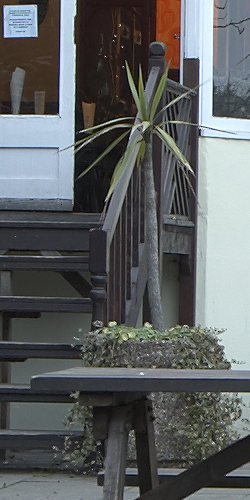 |
 |
 |
| Canon 16-35mm L II: Zone A at 17mm/f5 |
Contax 17-35mm: Zone A at 17mm/f5 |
Nikon 14-24mm: Zone A at 17mm/f5 |
Viewed in isolation, one might quickly leap to the conclusion that the Contax and Canon zooms are practically perfect in Zone A one stop down, but again the Nikon 14-24mm not only draws the scene with greater contrast and better colouring, but it draws a fraction more detail from it. In other words, if you're happy with your 16-35 L II or 17-35N, look away now . . . .
Resolution & Drawing Style: Zone B (mid frame) at 17mm f5
 |
 |
 |
| Canon 16-35mm L II: Zone B at 17mm/f5 |
Contax 17-35mm: Zone B at 17mm/f5 |
Nikon 14-24mm: Zone B at 17mm/f5 |
We've seen this behaviour before at shorter focal lengths in both the 'C' lenses: the Canon resolves very well centre frame at all apertures, but quickly deteriorates away from its Zone A sweet spot until well stopped down; the Contax performs strongly in Zones A and (amazingly) C from f4 down, but suffers from a pronounced Zone B dip. What we've not seen before (ever) is a lens that can shoot at this aperture and deliver that level of resolution across the frame. Welcome to a new era of ultrawide performance.
Resolution & Drawing Style: Zone C (corner) at 17mm f5
 |
 |
 |
| Canon 16-35mm L II: Zone C at 17mm/f5 |
Contax 17-35mm: Zone C at 17mm/f58 |
Nikon 14-24mm: Zone C at 17mm/f5 |
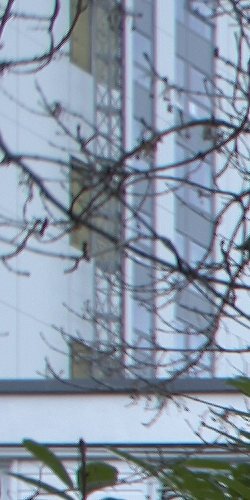 |
 |
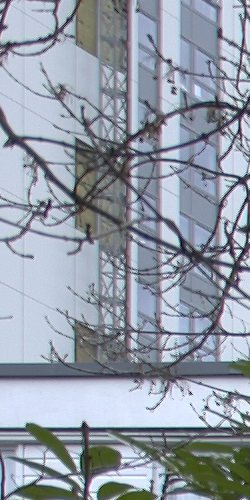 |
| Canon 16-35mm L II: Zone C at 17mm/f5 |
Contax 17-35mm: Zone C at 17mm/f5 |
Nikon 14-24mm: Zone C at 17mm/f5 |
We've a little wind spoiling the results here in the left side of Zone C, but scanning the whole of the capture, it's still very evident that the Nikon 14-24mm G is at least as attractive as the previously class-leading Contax N zoom with regard to corner performance. In fact, that statement may be over-charitable to the converted Zeiss lens when we factor in its relatively strong vignetting. As expected, the Canon L II lags behind by a considerable margin.
Resolution & Drawing Style: Zone A (centre frame) at 17mm f8
 |
 |
 |
| Canon 16-35mm L II: Zone A at 17mm/f8 |
Contax 17-35mm: Zone A at 17mm/f8 |
Nikon 14-24mm: Zone A at 17mm/f8 |
For lenses longer than about 24mm, we might consider f8 an optimal aperture: typically, wider lenses require an extra stop to peak. However, it is to their credit that all three of these state-of-the-art zooms aren't transformed from f5 to f8: we see a similar pattern repeat: the Nikon and Contax resolve and draw similarly – almost perfectly – centre frame (with kudos still going to the 14-24mm) and the Canon struggles to match them.
Resolution & Drawing Style: Zone B (mid frame) at 17mm f8
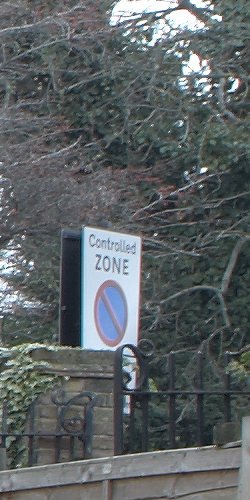 |
 |
 |
| Canon 16-35mm L II: Zone B at 17mm/f8 |
Contax 17-35mm: Zone B at 17mm/f8 |
Nikon 14-24mm: Zone B at 17mm/f8 |
Wow again.
Resolution & Drawing Style: Zone C (corner) at 17mm f8
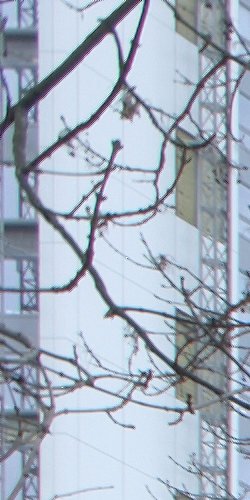 |
 |
 |
| Canon 16-35mm L II: Zone C at 17mm/f8 |
Contax 17-35mm: Zone C at 17mm/f8 |
Nikon 14-24mm: Zone C at 17mm/f8 |
Resolution & Drawing Style: Zone A (centre frame) at 17mm f13
 |
 |
 |
| Canon 16-35mm L II: Zone A at 17mm/f13 |
Contax 17-35mm: Zone A at 17mm/f13 |
Nikon 14-24mm: Zone A at 17mm/f13 |
Resolution & Drawing Style: Zone B (mid frame) at 17mm f13
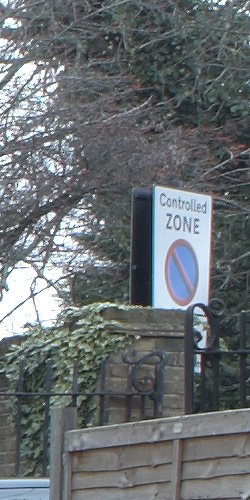 |
 |
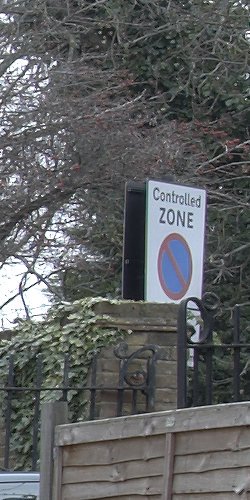 |
| Canon 16-35mm L II: Zone B at 17mm/f13 |
Contax 17-35mm: Zone B at 17mm/f13 |
Nikon 14-24mm: Zone B at 17mm/f13 |
Resolution & Drawing Style: Zone C (corner) at 17mm f13
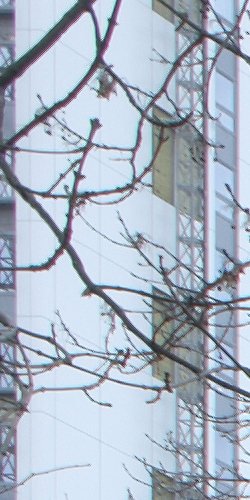 |
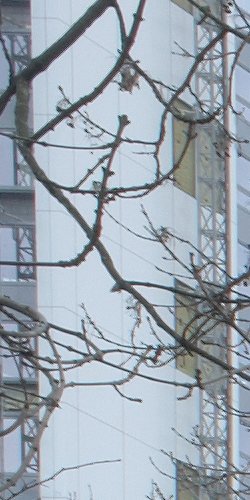 |
 |
| Canon 16-35mm L II: Zone C at 17mm/f13 |
Contax 17-35mm: Zone C at 17mm/f13 |
Nikon 14-24mm: Zone C at 17mm/f13 |
We're struggling to see diffraction effects at f13 evident on these Canon 1Ds Mark III captures: though there is some softening, it's subtle. Almost invariably, so much fine detail is crammed into a typical 17mm frame that in practice it can be hard to tell the difference between an ultrawide's resolving power at optimal apertures and its performance well stopped down. Though the difference would likely be revealed when shooting a near-field test chart, I can't think of a single practical application for which the distinction would be relevant when using a lens this wide. For all intents and purposes, f13 is sweet. At smaller apertures, the Nikon begins to show stronger traces of CA – another factor that incentivises the use of wider apertures than you may be accustomed to using. Astonishingly, even when faced with the challenge of a 22MP 36mm sensor, the Nikon 14-24mm G delivers so much at f5, you may only be stopping down for a little extra depth of field.
It's hard to convey in these 100% crops the absolute 'rightnesss' and transparency of the Nikon captures at 14mm and 17mm. Thanks to its superb microcontrast and pure colouring there's a limpid sense of 'being there' that I always associate with the best Zeiss and – to a lesser extent – Leica glass.
In conclusion, then, the Nikon 14-24mm f2.8 G would appear to dominate the 17mm focal length as surely as it does the 14mm. And that means that it's dominance is unchallenged right up to 21mm where we encounter the benchmark-of-benchmarks Zeiss Distagon prime. Owners of the Olympus 18mm or Leica 19mm may protest, but remember that tests on the less demanding 5D and 1Ds II showed significant weaknesses in each case: at the time of writing, I've never seen a Zuiko 18mm that can match the centre frame performance of a Zeiss 18mm or Leica 19mm, which in turn was very closely matched by the 16-35mm L II we see so comprehensively bettered above. Unlike the Leica 19mm, the Olympus has a very sweet C Zone – but it's no better than the Contax N's which – again – we see thoroughly trounced by the Nikon above.
For sheer resolution, contrast and colouring – all the important elements of 'drawing style', tested in the fiercest crucible yet devised, the 14-24mm G is a long, long way ahead of anything below 21mm. Even if it covered 14-20mm and cost $4000 it would be the best possible ultrawide for a 1Ds III – but it doesn't: it costs less than half that, and it goes to 24mm, where it comes into conflict with the mighty Distagon . . . coming soon!
Return to 16:9 home page >